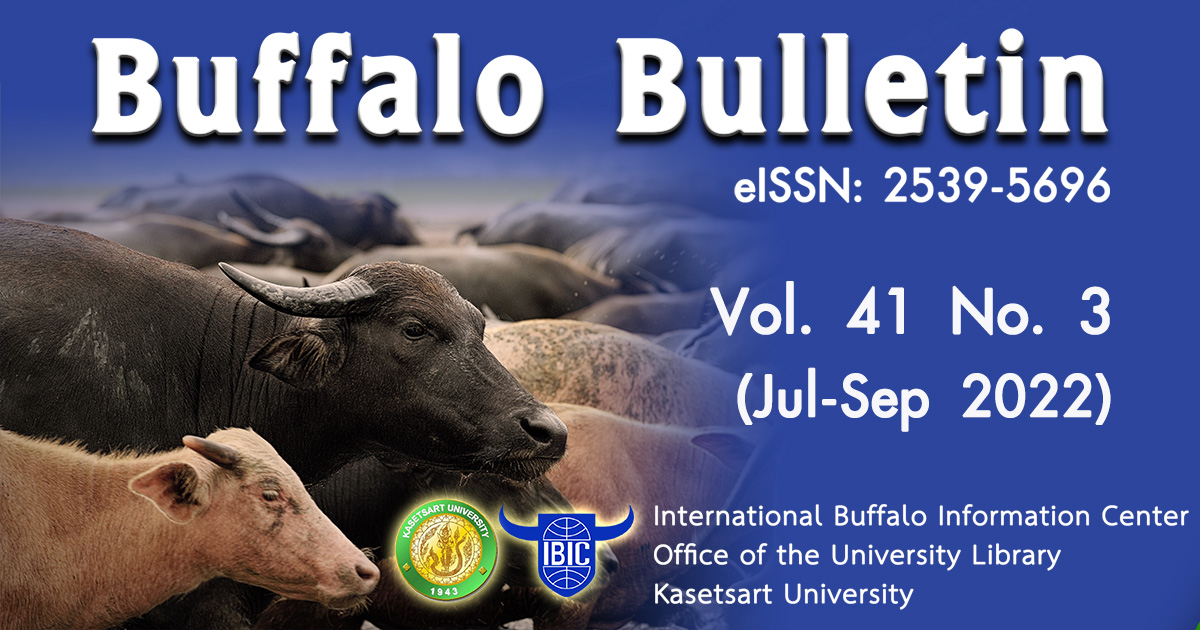Dystocia due to Dicephalic dipus dibrachius monster in a Murrah buffalo
DOI:
https://doi.org/10.56825/bufbu.2022.4133070Keywords:
Bubalus bublis, buffaloes, caesarean section, Dicephalalus dipus dibrachius dicaudatus, fetal monsterAbstract
A four year old Murrah buffalo at full term in second parity suffering from dystocia was presented to the Veterinary Clinical Complex and the fetal monster was delivered by caesarean section. The fetus was Dicephalic dibrachius dipus dicaudatus along with partial duplication of spine.
Downloads
Download data is not yet available.
Metrics
Metrics Loading ...
References
Batra, K., A. Tewari and R.K. Chandolia. 2015. Incidence of fetal monstrosities in India: A review. Theriogenology Insight, 5(3): 219. DOI: 10.5958/2277-3371.2015.00024.8
Bhoi, D.B. 2009. Conjoined sternopagus twin monster: A cause of dystocia in Mehsana buffalo. Vet. World, 2(8): 327. Available on: http://www.veterinaryworld.org/Vol.2/August/Conjoined%20Sternopagus%20Twin%20monster%20%20A%20cause%20of%20Dystocia%20in%20M.pdf
Chauhan, P.M., H.C. Nakhashi, B.N. Suthar and V.R. Parmar. 2012. Dicephalus, monostomus, tetraopthalmus, dipus, dibrachius, dicandatus monster in a Kankrej cow. Vet. World, 5(1): 38-39. DOI: 10.5455/vetworld.2012.38-39
Dhami, A.J., M.T. Panchal and F.S. Kavani. 2000. Dystocia due to holo acardius acephalic (Asymmetrical conjoined twin) monster in a buffalo. Indian J. Anim. Reprod., 21(2): 162-164.
Dutt, R., V. Arjun, Hariom and G. Singh. 2019. Dystocia due to dicephalic fetus in a cross bred jersey cow. International Journal of Agriculture Sciences, 11(10): 8509-8510.
Dutt, R., G. Singh, S.C. Gahalot, S. Patil, G. Kumar and R.K. Chandolia. 2018. A rare case of dicephalus derodymus monster in a primiparous Murrah buffalo: A case report. Theriogenology Insight - An International Journal of Reproduction in all Animals, 8(2): 49-52. DOI: 10.30954/2277-3371.02.2018.1
Hannappagol, S.S., M.H. Tandle and V. Ramakrishna. 2005. Thoraco abdominopygophagus fetal monster in a non-Descript cow. Indian Vet. J., 82(4): 441.
Jones, T.C. and R.D. Hunt. 1983. Veterinary Pathology, 5th ed. Lea and Febiger, Philadelphia, USA. 115.
Long, L.S. 2009. Abnormal development of the conceptus and its consequences. In Noakes, D.E., T.J. Parkinson and G.C.W. England (eds.) Veterinary Reproduction and Obstetrics, Saunders Ltd., London, UK.
McGirr, W.J., G.D. Partlow and K.R. Fisher. 1987. Two-headed, two-necked conjoined twin calf with partial duplication of thoracoabdominal structures: Role of blastocyst hatching. Anat Rec., 217(2): 196-202. DOI: 10.1002/ar.1092170212
Mee, J.F. 2008. Prevalence and risk factors for dystocia in dairy cattle: A review. Vet. J., 176(1): 93-101. DOI: 10.1016/j.tvjl.2007.12.032
Morrow, D.A. 1986. Congenital defects affecting bovine reproduction. Current Therapy in Theriogenology, 2nd ed. W.B. Saunders Co., Philadelphia, USA. p. 177-199.
Praharaj, P., B. Jena, S. Das and D.N. Mohanty. 2015. Dystocia due to dicephalus dipus dibrachius dicaudatus monster with spina bifida condition in a red Sindhi cow. Indian Vet. J., 92(6): 55-56.
Ravikumar, K., K. Krishnakumar, R.N. Ezakial and C. Chandrahasan. 2012. Per-vaginal delivery of a Dicephalus dicaudatus xiphophagus monster. Indian J. Anim. Reprod., 33(2): 96-97.
Roberts, S.J. 1971. Veterinary Obstetrics and Genital Diseases, 2nd ed. CBS Publisher and Distributors, New Delhi, India. p. 49-80, 227-233.
Singh, G., R. Dutt, V. Yadav and S. Patil. 2018. Successful management of dystocia due to dicephalus fetal monster in a Murrah buffalo. International Journal of Science and Nature, 9(2): 258-259.
Singh, G., A.K. Pandey, D. Agnihotri, S. Chander, R.K. Chandolia and R. Dutt. 2013. Survival and fertility rate in buffaloes following caesarean section and mutation with/without partial fetotomy. Indian J. Anim. Sci., 83(3): 251-253.
Bhoi, D.B. 2009. Conjoined sternopagus twin monster: A cause of dystocia in Mehsana buffalo. Vet. World, 2(8): 327. Available on: http://www.veterinaryworld.org/Vol.2/August/Conjoined%20Sternopagus%20Twin%20monster%20%20A%20cause%20of%20Dystocia%20in%20M.pdf
Chauhan, P.M., H.C. Nakhashi, B.N. Suthar and V.R. Parmar. 2012. Dicephalus, monostomus, tetraopthalmus, dipus, dibrachius, dicandatus monster in a Kankrej cow. Vet. World, 5(1): 38-39. DOI: 10.5455/vetworld.2012.38-39
Dhami, A.J., M.T. Panchal and F.S. Kavani. 2000. Dystocia due to holo acardius acephalic (Asymmetrical conjoined twin) monster in a buffalo. Indian J. Anim. Reprod., 21(2): 162-164.
Dutt, R., V. Arjun, Hariom and G. Singh. 2019. Dystocia due to dicephalic fetus in a cross bred jersey cow. International Journal of Agriculture Sciences, 11(10): 8509-8510.
Dutt, R., G. Singh, S.C. Gahalot, S. Patil, G. Kumar and R.K. Chandolia. 2018. A rare case of dicephalus derodymus monster in a primiparous Murrah buffalo: A case report. Theriogenology Insight - An International Journal of Reproduction in all Animals, 8(2): 49-52. DOI: 10.30954/2277-3371.02.2018.1
Hannappagol, S.S., M.H. Tandle and V. Ramakrishna. 2005. Thoraco abdominopygophagus fetal monster in a non-Descript cow. Indian Vet. J., 82(4): 441.
Jones, T.C. and R.D. Hunt. 1983. Veterinary Pathology, 5th ed. Lea and Febiger, Philadelphia, USA. 115.
Long, L.S. 2009. Abnormal development of the conceptus and its consequences. In Noakes, D.E., T.J. Parkinson and G.C.W. England (eds.) Veterinary Reproduction and Obstetrics, Saunders Ltd., London, UK.
McGirr, W.J., G.D. Partlow and K.R. Fisher. 1987. Two-headed, two-necked conjoined twin calf with partial duplication of thoracoabdominal structures: Role of blastocyst hatching. Anat Rec., 217(2): 196-202. DOI: 10.1002/ar.1092170212
Mee, J.F. 2008. Prevalence and risk factors for dystocia in dairy cattle: A review. Vet. J., 176(1): 93-101. DOI: 10.1016/j.tvjl.2007.12.032
Morrow, D.A. 1986. Congenital defects affecting bovine reproduction. Current Therapy in Theriogenology, 2nd ed. W.B. Saunders Co., Philadelphia, USA. p. 177-199.
Praharaj, P., B. Jena, S. Das and D.N. Mohanty. 2015. Dystocia due to dicephalus dipus dibrachius dicaudatus monster with spina bifida condition in a red Sindhi cow. Indian Vet. J., 92(6): 55-56.
Ravikumar, K., K. Krishnakumar, R.N. Ezakial and C. Chandrahasan. 2012. Per-vaginal delivery of a Dicephalus dicaudatus xiphophagus monster. Indian J. Anim. Reprod., 33(2): 96-97.
Roberts, S.J. 1971. Veterinary Obstetrics and Genital Diseases, 2nd ed. CBS Publisher and Distributors, New Delhi, India. p. 49-80, 227-233.
Singh, G., R. Dutt, V. Yadav and S. Patil. 2018. Successful management of dystocia due to dicephalus fetal monster in a Murrah buffalo. International Journal of Science and Nature, 9(2): 258-259.
Singh, G., A.K. Pandey, D. Agnihotri, S. Chander, R.K. Chandolia and R. Dutt. 2013. Survival and fertility rate in buffaloes following caesarean section and mutation with/without partial fetotomy. Indian J. Anim. Sci., 83(3): 251-253.
Downloads
Published
2022-09-27
How to Cite
Singh, G., -, H., Dutt, R., Kumar, A., & Venkateshappa, A. (2022). Dystocia due to Dicephalic dipus dibrachius monster in a Murrah buffalo. Buffalo Bulletin, 41(3), 417–421. https://doi.org/10.56825/bufbu.2022.4133070
Issue
Section
Case Report









.png)








